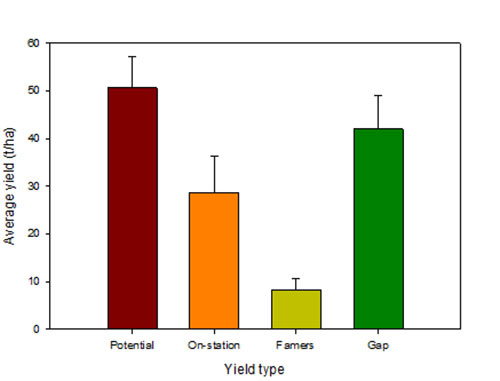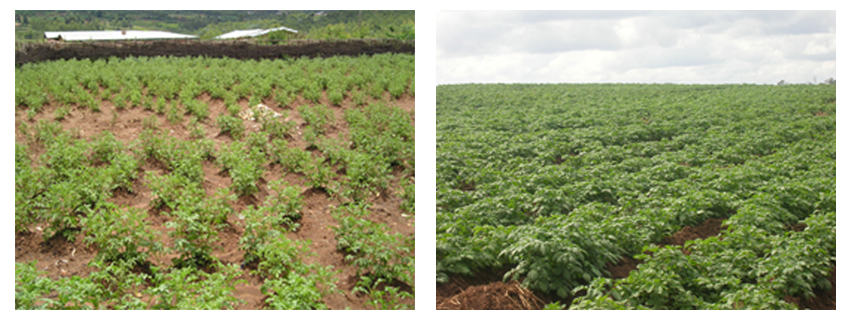Yield gap analysis is an important tool to estimate to what extent production could be increased if all factors are controlled and non-limiting. While this information is well documented for cereals, much remains to be done on other commodities such as potatoes. A challenge in this endeavor is the scalability of the analysis, as data are usually scarce in developing countries including Sub-Saharan Africa (SSA). To this end, scientists recommended using simulation models but their parameterization can be a difficult task.
In this context a regional study was conducted in SSA in order to estimate the potato yield gaps. Scientists from West Africa (Nigeria), Eastern and Central Africa (Cameroon, Burundi, Rwanda, Kenya, Uganda, Tanzania, Democratic Republic of Congo and Ethiopia), and Southern Africa (Angola, Malawi, Madagascar and Mozambique) participated in the study. A wide knowledge of the crop was one of the pre-requisites to attend the workshops, as the study is based on historical field data in most cases with missing parameters that had to be estimated using technological tools but with validation by experts. The experience working on the crop ranged from 8 to 31 years for 67% of the participants. This was the main driver of the workshops as field data for modeling purposes are seldom complete in most developing countries in general and SSA in particular.
The first task was to get the scientists acquainted with key concepts such as systems research and yield gap analysis as well as with the tools to be used in the exercise. This was achieved in two workshops held, respectively, in Nairobi, Kenya and then Addis Ababa, Ethiopia (October 14-18, 2013). The big challenge was to estimate the parameters to feed the Solanum model developed by CIP. To this end, a Parameter Estimator routine was developed but the expert opinion was essential to achieve reliable values prior to simulations.
This gap analysis was conducted on 12 genotypes that have been evaluated in different breeding Programs. Those genotypes are as follows: Victoria (Asante), Dosa, CIP395112.9, Guassa (CIP384321.9), Gudene (CIP386423.13), Kenya Mpya (CIP393371.58), Unica (CIP392797.22), Meva (CIP377957.5), Lulimile (Tigoni), Diamant, CIP396038.107, and CIP396036.201. All these materials come from CIP except for Dosa, grown in Cameroon, and Diamant, found in Nigeria.
By the end of the second workshop, all the participants, who had brought their data, completed the simulations prior to receiving certificates of attendance. The following graph shows clearly that yield gaps exceeded the best yields normally obtained on-station.

This information suggests that there is a high potential in SSA to increase potato production if investments are made to optimize the defining production factors and manage limiting and reducing factors adequately.

Countries from Southern Africa show higher potato tuber yields than the ones located near the equator: Smallholder potato field in Mwaro, Burundi (left) and Commercial private farm in Chimoio, Mozambique (right). Photos: D. Harahagazwe (CIP)
Another lesson from the study is the scarcity of data in SSA for modeling purposes – mainly reliable weather data and agrophysiological traits of germplasm used – as well as agricultural statistics.
In this first phase of the study, the focus was site-specific. The way forward is to scale up/out the application of the tools and give a geospatial dimension to this analysis. To this end, all participating scientists committed themselves to launch an initiative called “Climate-Smart Potato in SSA” whose objectives are as follows: (i) Characterize potato environments in different target countries using geospatial analysis tools; (ii) Understand and document the agrophysiological traits of most potato varieties grown in the region; (iii) Predict the behavior of most potato varieties grown in SSA in a changing environment (yield gap, suitable areas, and climate change) through modeling in responding to questions like “what if…?” and (iv) Develop and promote a community of practice for a climate-smart potato in SSA.
A blog produced by CIP’s Production System and Environment Sub-Program
Acknowledgements
This study was co-funded by three CGIAR Research Programs: “Climate Change, Agriculture and Food Security” (CCAFS), “Roots, Tubers and Bananas” (RTB) and “Humidtropics”. Authors are grateful to NASA for their open-access Web-based weather data.
Full paper: R. Quiroz, D. Harahagazwe, B. Condori, C. Barreda, F. de Mendiburu, A. Amele, D. Anthony, E. Atieno, A. Bararyenya, A. A. Byarugaba, P. Demo, J. Guerrero, B. Kowalski, D. Anthony Kude, C. Lung’aho, V. Mares, D. Mbiri, G. Mulugeta, B. Nasona, A. Ngugi, J. Njeru, B. Ochieng, J. Onditi, M. Parker, J. M. Randrianaivoarivony, E. Schulte-Geldermann, C. M. Tankou, G. Woldegiorgis and A. Worku. 2014. Potato yield gap analysis in SSA through participatory modeling: Optimizing the value of historical breeding trial data. CIP Working Paper.
For more information, please contact Roberto Quiroz, International Potato Center (CIP), P.O. Box 1558, Lima, Peru, e-mail: r.quiroz@cgiar.org, Tel. +511 3175304/3175312
